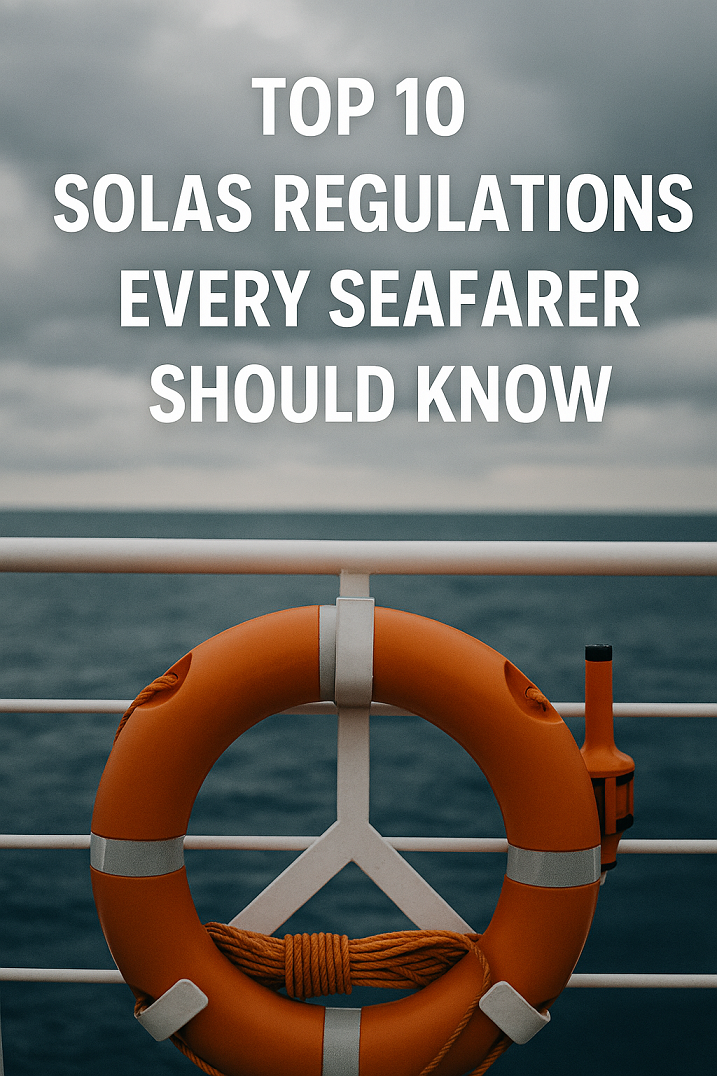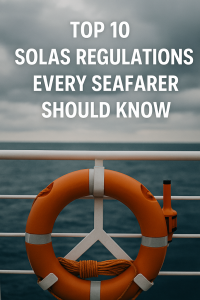Discover the top 10 SOLAS regulations every seafarer must know. Learn how these maritime safety rules impact daily operations, prevent disasters, and save lives at sea in this comprehensive guide.
Why SOLAS Regulations Matter in Modern Maritime Operations
For over a century, the International Convention for the Safety of Life at Sea (SOLAS) has stood as the backbone of global maritime safety. Originally developed in response to the Titanic disaster of 1912, SOLAS has evolved into a dynamic framework designed to safeguard lives, vessels, and cargo across the world’s oceans.
But SOLAS isn’t just for flag states or shipowners—it’s a daily companion for every seafarer, from junior deck cadets to experienced masters. A deep understanding of key SOLAS regulations isn’t optional; it’s a professional imperative.
In an industry where one misstep can result in loss of life or environmental catastrophe, familiarity with these regulations can mean the difference between crisis and control. This article breaks down the top 10 SOLAS regulations every seafarer should know, using practical examples, data, and historical context to explain their importance.
1. Regulation II-1: Construction – Subdivision and Stability, Machinery and Electrical Installations
This regulation focuses on ensuring that a ship remains stable and buoyant even after sustaining damage. All commercial vessels must be designed with compartmentalized structures that prevent flooding from spreading.
Real-World Example: In 1987, the Herald of Free Enterprise capsized due to flooding through an open bow door. The tragedy highlighted the need for stricter compartmentalization and operational compliance.
2. Regulation II-2: Fire Protection, Detection and Extinction
Keywords: fire safety SOLAS, fire detection systems, fire drills
This is one of the most crucial SOLAS chapters. It mandates:
-
Fire-retardant construction materials
-
Automatic fire detection and alarm systems
-
Fire suppression equipment, including CO₂ and sprinkler systems
-
Routine fire drills and training
Stat: According to the EMSA Annual Review (2023), fire and explosion incidents accounted for 13% of all shipboard casualties.
Modern ships are equipped with integrated fire zones, smoke detectors in accommodation spaces, and emergency escape routes—all required under this chapter.
3. Regulation III: Life-Saving Appliances and Arrangements
This regulation covers the equipment and procedures that ensure crew survival in emergencies. Every seafarer must know:
-
Lifeboat and life raft launching procedures
-
Location and operation of EPIRBs (Emergency Position Indicating Radio Beacons)
-
Donning of immersion suits and lifejackets
Analogy: Think of these tools like a firefighter’s turnout gear. You may rarely use them, but knowing exactly how and when to use them can save your life.
4. Regulation V: Safety of Navigation
Chapter V is unique—it applies to all vessels, including pleasure craft. It requires:
-
Up-to-date nautical charts and publications
-
Adequate bridge equipment (radars, compasses, echo sounders)
-
Watchkeeping practices in line with STCW standards
Key Provision: All ships must continuously keep a proper lookout using sight, hearing, and all available means, including radar and AIS.
Case Example: The MSC Napoli incident in 2007 saw the ship deliberately grounded after structural failure. The crew’s adherence to SOLAS navigation and emergency regulations ensured the entire crew was rescued safely.
5. Regulation XI-1: Special Measures to Enhance Maritime Safety
Introduced in response to enforcement challenges, this regulation grants port authorities the right to inspect foreign ships to verify SOLAS compliance.
Why It Matters: Even if a ship is SOLAS-compliant at the design level, poor maintenance or training can lead to detention at port, financial losses, and reputational damage.
6. Regulation II-1/29: Steering Gear and Emergency Steering Drills
Every seafarer involved in navigation should be aware that SOLAS mandates:
-
Emergency steering drills every three months
-
Testing of steering systems before departure
-
Immediate response plans for steering failure
Real-Life Scenario: A steering failure in confined waters—without a trained bridge team—could lead to collision or grounding within minutes.
7. Regulation VI: Carriage of Cargoes and Oil Fuels
This chapter addresses the safe loading, stowing, and securing of cargo. It includes:
-
Documentation of cargo type and stability calculations
-
Use of approved securing equipment
-
Compliance with the IMDG Code (for dangerous goods)
Stat: Improper stowage is responsible for over 50% of container-related fires, according to the TT Club (2021).
8. Regulation X: Safety Measures for High-Speed Craft (HSC Code)
While not every vessel falls under this regulation, many ferries, naval support vessels, and offshore craft do. These ships face unique stability and fire risks due to their high speeds and lightweight designs.
HSC Requirements Include:
-
Enhanced evacuation systems
-
Shock-absorbing seating
-
Rapid communication systems with shore authorities
9. Regulation XI-2: Ship and Port Facility Security (ISPS Code)
Developed after 9/11, this regulation addresses threats from terrorism and piracy. Ships must:
-
Appoint a Ship Security Officer (SSO)
-
Conduct regular security drills
-
Maintain restricted access to sensitive areas onboard
Example: In the Gulf of Aden, strict ISPS compliance helped reduce piracy incidents by over 90% between 2011 and 2018 (ICS Report, 2019).
10. Regulation I: General Provisions and Certification
This SOLAS chapter outlines the requirement for certification of compliance:
-
Safety Construction Certificate
-
Safety Equipment Certificate
-
Safety Radio Certificate
Importance: These certificates are your proof of SOLAS compliance during port inspections or audits.
Real-World Applications: SOLAS in Action
-
Titanic (1912): Its sinking led to the first version of SOLAS in 1914.
-
Estonia Ferry Disaster (1994): Prompted stricter regulations on bow visor locking mechanisms under SOLAS amendments.
-
Costa Concordia (2012): Emphasized the need for improved emergency training and lifeboat accessibility.
FAQ: SOLAS Regulations Explained
Q1: What does SOLAS stand for?
A: The International Convention for the Safety of Life at Sea.
Q2: Who enforces SOLAS regulations?
A: Flag states, port state control authorities, and recognized classification societies.
Q3: Are SOLAS regulations mandatory for all vessels?
A: SOLAS applies primarily to commercial vessels over 500 GT, but some parts (like Chapter V) apply universally.
Q4: How often is SOLAS updated?
A: Regularly through IMO’s Maritime Safety Committee (MSC) meetings and amendments.
Q5: What happens if a ship violates SOLAS rules?
A: Detention, fines, or denial of port entry—plus potential insurance and legal repercussions.
Q6: How do seafarers stay updated on SOLAS changes?
A: Through official bulletins, company safety management systems, and training refreshers.
Q7: Are all SOLAS chapters equally relevant to seafarers?
A: Not necessarily; some are more technical or structural, while others directly affect day-to-day operations.
Conclusion
SOLAS is more than a legal framework—it’s a lifeline. For today’s seafarers, understanding the top 10 SOLAS regulations isn’t about compliance for its own sake. It’s about being prepared, professional, and responsible for the lives onboard and the seas we navigate.
From fire safety to cargo handling, from navigation to security, SOLAS provides the compass by which maritime operations are steered. Make these ten regulations part of your professional knowledge—and pass them on.
Call to Action: For more in-depth guides on maritime safety, navigation, and certification, visit our SOLAS Knowledge Center.
References
-
International Maritime Organization. (2024). SOLAS Consolidated Edition 2020. https://www.imo.org
-
European Maritime Safety Agency (2023). Annual Overview of Marine Casualties. https://emsa.europa.eu
-
TT Club. (2021). Container Shipping Risk Assessment. https://www.ttclub.com
-
International Chamber of Shipping. (2019). Piracy and Armed Robbery Report. https://www.ics-shipping.org


